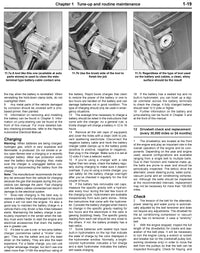A blown head gasket is definitely going to spoil your day. If you even think yours might be going, act now. That's because a head gasket can fail seven slightly different ways, which we list here, all of which are potentially catastrophic for the engine. However, one of the clues to a blown head gasket is a sweet-smelling white cloud behind you. If that's happening, stop the engine right away.
Typically head gaskets fail when the cylinder head and the engine block expand at different rates as the engine is warming up, and the gasket can't seal the newly expanded gap. This issue is made worse on some motors that have an iron cylinder block and an aluminum head. Moreover, some engines are just designed with poor clamping force from the head bolts, or have heads prone to warping, and a reputation for failure.
Once a head gasket has failed it can cause all manner of problems, including:
1) Overheating
An engine overheating one too many times (as a result of a clogged radiator, coolant leak, faulty fan, etc.) can cause head gasket failure but, conversely, a blown head gasket can also cause the engine to overheat. Hot exhaust gases can leak into the cooling system, or coolant can leak into the cylinders and be burned off as steam, either way, the end result is an overheating engine.
If the car is driven while overheating, it can also result in the alloy cylinder head warping, or steam damaging the catalytic converter, adding significantly to the cost of repair.
2) Loss of power
If a failed head gasket allows compressed air/fuel to escape, the compression of that cylinder is reduced. This loss of compression results in a rough running engine and a notable reduction in engine power. This sort of failure typically is accompanied by a sound like an exhaust leak.
3) Oil contamination
One of the clearest signs of head gasket failure is the milky sludge on the underside of the oil filler cap or the dipstick, sometimes jokingly called a "milkshake" or "mayonnaise". This is caused by coolant getting into the oil, and vice versa. Although not conclusive proof of head gasket failure this is generally a good indicator and is a sure sign your engine needs to come apart to find the source of contamination.
This also means antifreeze will have contaminated the oil, so any driving will quickly ruin the engine’s bearings. Repair requires an engine oil flush at the very least, plus a replacement oil filter, and often complete disassembly of the bottom end of the engine to ensure the bearings aren't damaged and clear out all contaminated oil.
4) White Smoke
A faulty head gasket most often results in billowing clouds of sweet-smelling white smoke coming from the exhaust. Thie smoke is caused by antifreeze leaking past the gasket and into the cylinders, where it is turned to steam as part of the combustion process. Less common, but still possible, is a leak from an oil passage to the cylinder, which would cause blueish smoke.
Either of these types of gasket failure will also allow combustion pressure into the cooling system or oil breather system. If a radiator hose suddenly blows off its water outlet, or the dipstick won't stay put, this could be the reason.
5) External leaks
If a cylinder head gasket has blown between the water or oil passage and the outside of the engine, the result can be a simple coolant or oil leak. This is the least dire version of a blown head gasket, but is serious nonetheless.
An external leak may not manifest itself as an immediate problem (other than causing a mess), but if the coolant level is allowed to drop too far, it can lead to serious engine issues. The other issue is that leaking oil could get on the hot exhaust leading to acrid smoke, and possibly fire.

How to Prevent Head Gasket Failures
It's much better to spend a few dollars now than several hundred dollars afterwards to cure a blown head gasket. Yes, the replacement gasket itself isn't expensive, but all the dismantling and reassembly is labour-intensive, which significantly increases the cost of repair, especially on modern cars.
A head gasket will often fail after repeated overheating or if you continue to drive after the car has overheated, so the best way to prevent a head gasket failure is to ensure your cooling system is in good condition. If your vehicle does start to boil over, stop, let it cool for at least an hour, and refill the radiator before continuing.
The good news is that checking the cooling system is easy. All you need to do is check all the pipes and joins for leaks (you'll see the dampness if there is a leak), make sure the radiator is working efficiently, the thermostat opens properly, and the coolant is topped up to the correct level. Also make sure the fan (mechanical or electric) is working, has all of its blades, and has a shroud around it to increase the efficiency.
If you suspect a head gasket failure, the scientific test is to check for combustion gases in the cooling system. This test will show if the compression has leaked into the cooling system, and therefore if the head gasket has blown. The old mechanic's trick is to take off the radiator cap (only when the cooling system is cold!), start the car, and look for bubbles in the coolant.
However, these will not show if there are any other failure spots in with the head gasket, so the absence of gases in the cooling system does not guarantee a healthy head gasket.
Some older head gaskets fail because they are either a poor design, are not robust enough – or both. This used to be more of an issue with older metal gaskets, which would last only for so many years of going from cold to hot before an inevitable failure. Thankfully modern MLS (multiple layer steel) replacement gaskets are now available for most applications, and offer improved reliability.



























